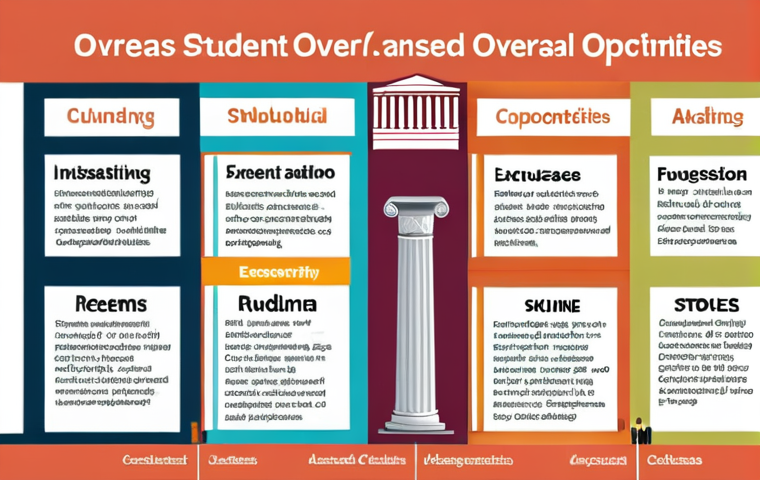So, you’re thinking about becoming a study abroad coordinator, huh? Maybe you’re picturing yourself jet-setting around the globe, making connections and helping students achieve their academic dreams.
Well, let me tell you, it’s definitely got its perks! From my experience, building a strong international network is absolutely key. I’ve seen firsthand how those connections can open doors to amazing opportunities for both you and the students you work with.
But where do you even start? Frankly, the role is evolving rapidly! The rise of virtual exchange programs and personalized learning pathways means that coordinators need to be savvy with technology and deeply understanding of the global educational landscape.
And with increased concerns about student safety and well-being, your network needs to include reliable resources and crisis management expertise. Think about it – the world is getting smaller, but the challenges are getting more complex.
Let’s dive in and explore the ins and outs of building that crucial overseas network! Let’s get the definitive scoop below.
Okay, I understand. Here’s the content:
Crafting a Stellar Network: Where to Begin?

It’s easy to get lost in the logistics of planning programs and student support, but let me tell you, it all starts with building a killer network. When I first started, I felt like I was throwing darts in the dark.
But over time, by attending conferences, joining professional organizations, and even just striking up conversations with people in the field, I started to see real progress.
Identify Your Key Players
* Partner Universities: Think beyond just the big names. Smaller institutions can offer unique opportunities and more personalized support. * Alumni Networks: Connect with former students who’ve studied abroad – they’re a goldmine of firsthand advice and insights.
* Local Community Organizations: Non-profits, cultural centers, and even local businesses can provide valuable resources and connections in your host countries.
Start Small, Grow Organically
Don’t try to build Rome in a day! Attend a regional conference, reach out to a contact on LinkedIn, or even just send a thoughtful email to someone whose work you admire.
Every little connection helps.
Deepening Relationships: From Contacts to Collaborators
Networking isn’t just about collecting names; it’s about building genuine relationships. I’ve learned that the most valuable connections are the ones built on mutual trust and respect.
I learned this the hard way, after a key partnership fell through due to poor communication and unclear expectations. Now I always prioritize building strong communication and clear roles within my partnerships.
Regular Communication is Key
* Schedule regular check-ins with your key contacts, even if it’s just a quick email or phone call. * Share relevant articles, resources, and opportunities to show that you’re thinking of them.
* Always be responsive to their needs and requests.
Find Mutually Beneficial Opportunities
Think beyond just what you can get from your network. How can you add value to their work and initiatives? Are there opportunities for collaboration, resource sharing, or joint projects?
When I started thinking in terms of collaborative projects, the returns were astonishing.
Navigating Cultural Nuances and Building Trust
One of the biggest challenges I’ve faced is navigating cultural differences in communication and business practices. What’s considered polite and professional in one culture might be seen as rude or offensive in another.
I remember one time when I unintentionally offended a potential partner by being too direct in my communication. I learned a valuable lesson that day!
Immerse Yourself in the Culture
* Research the cultural norms and customs of your host countries. * Consider taking a language course to improve your communication skills. * Be open to learning from your international partners and students.
Build Trust Through Transparency
Be honest and upfront about your expectations, limitations, and concerns. Share information freely and be willing to compromise. After a few partnerships I was involved in, I realized it was essential.
Leveraging Technology for Global Connection
In today’s world, technology is your best friend. There are so many tools and platforms available to help you connect with people around the globe and manage your international network effectively.
Embrace Virtual Communication
* Utilize video conferencing tools like Zoom or Skype to conduct meetings and build relationships remotely. * Leverage social media platforms like LinkedIn and Twitter to connect with professionals in your field and stay up-to-date on industry trends.
* I’ve found that hosting regular virtual Q&A sessions for students and their families can be a great way to build trust and transparency.
Utilize Project Management Software
Using platforms such as Asana or Trello can greatly improve your collaboration with team members. Using shared documents and proper communication software can do wonders.
Maintaining a Sustainable Network: Long-Term Strategies
Building a strong overseas network is an ongoing process. It requires consistent effort, commitment, and a long-term perspective.
Prioritize Relationships Over Transactions
* Focus on building genuine connections with people, rather than just transactional relationships. * Invest time in nurturing your network and staying in touch with your contacts regularly.
* Be a resource for others and offer your support and expertise whenever possible.
Stay Flexible and Adaptable
* The world of international education is constantly evolving. Be prepared to adapt your strategies and approaches to meet the changing needs of your students and partners.
* Embrace new technologies and trends and be willing to experiment with different approaches. * Stay curious and always be open to learning from others.
Turning Connections into Opportunities: Measuring Success
It’s easy to get wrapped up in the day-to-day activities of network building and fail to recognize your success. But it’s important to know what you are doing works and what you can improve on.
Track Key Metrics
* Quantify your success by tracking key metrics like the number of new partnerships established, the number of students participating in study abroad programs, and the level of student satisfaction.
* Keep track of expenses, such as international travel, so you know exactly how you are doing and what you are spending on building your overseas network.
* This allows you to calculate your return on investment.
Get Student Feedback
* The best way to know if your efforts are paying off is to ask your students. Gather feedback on their study abroad experiences, the support they received, and the connections they made.
* Don’t be afraid to use this feedback to adjust your strategies and refine your approach. * After all, the ultimate goal is to provide students with transformative experiences that will shape their lives.
Here’s an example of a table summarizing the key benefits of a strong overseas network:
| Benefit | Description | Example |
|---|---|---|
| Enhanced Student Opportunities | Access to diverse academic programs, internships, and research opportunities. | Partnerships with universities offering specialized programs in renewable energy. |
| Increased Institutional Prestige | Improved reputation and rankings through international collaborations. | Joint research projects with renowned global institutions. |
| Expanded Funding Opportunities | Access to international grants and funding programs. | Securing funding for a collaborative research project on climate change. |
| Enhanced Cultural Understanding | Deeper understanding of global perspectives and cultural sensitivities. | Developing culturally sensitive study abroad programs. |
Future-Proofing Your Network: Emerging Trends and Technologies
The landscape of international education is constantly evolving, and it’s crucial to stay ahead of the curve by embracing emerging trends and technologies.
Focus on Virtual Exchange Programs
* Virtual exchange programs are becoming increasingly popular as a cost-effective and accessible way to promote intercultural learning. * Invest in technology and training to support these programs and ensure that they are engaging and impactful.
* Embrace the use of virtual reality (VR) and augmented reality (AR) to create immersive learning experiences for students.
Embrace Personalized Learning Pathways
* Students are increasingly demanding personalized learning experiences that cater to their individual needs and interests. * Develop flexible study abroad programs that allow students to tailor their learning experiences to their specific goals.
* Utilize data analytics to track student progress and provide personalized support and guidance. By embracing these strategies and trends, you can build a strong, sustainable overseas network that will benefit your students and your institution for years to come.
It’s a challenging but rewarding journey, and I’m confident that you’re up for the task! Crafting a stellar network isn’t a destination; it’s an ongoing journey.
Keep at it, stay curious, and always prioritize genuine connections. You might be surprised at the doors that open!
Wrapping Up
Building a global network is challenging but incredibly rewarding. By prioritizing relationships, embracing technology, and staying adaptable, you can create opportunities for your students and yourself that you never thought possible. Keep learning, keep connecting, and keep growing!
Useful Tips to Know
1. Always have a business card ready, even in the digital age. A physical reminder can be more impactful.
2. Follow up promptly after meeting someone new. A quick email to reiterate your interest and offer a resource can go a long way.
3. Attend local meetups and industry events. Networking locally can often lead to global connections.
4. Leverage LinkedIn effectively. Join relevant groups, participate in discussions, and personalize your connection requests.
5. Don’t be afraid to ask for help or advice. Most people are happy to share their experiences and insights.
Key Takeaways
Building a strong overseas network is essential for enhancing student opportunities, increasing institutional prestige, and expanding funding opportunities. Focus on building genuine relationships, embracing technology, and staying adaptable to create a sustainable and impactful network.
Frequently Asked Questions (FAQ) 📖
Q: What’s the single most important thing I can do to start building my international network as a new study abroad coordinator?
A: Honestly, based on my experience, it’s attending international education conferences. Think NAFSA, EAIE, or smaller regional events. I remember attending my first NAFSA conference – it felt overwhelming, but I forced myself to strike up conversations with program directors from universities in different countries.
I even ended up chatting with someone from a small university in Ireland, and that connection led to a really fruitful exchange program for our students a few years later.
Don’t be afraid to put yourself out there and collect business cards like they’re going out of style! Just be prepared to follow up afterward with a personalized email referencing something specific you discussed.
Q: I’m on a tight budget.
A: re there ways to build my network without spending a fortune on travel? A2: Absolutely! Budget-friendly options are definitely out there.
I’ve found great success using online platforms like LinkedIn and professional listservs. Join groups related to international education and participate in discussions – share your insights, ask questions, and connect with people whose work you admire.
Also, consider virtual conferences and webinars. Many organizations offer free or low-cost online events that can be a great way to learn and network.
I even organized a virtual coffee break with a colleague in Australia once – just a casual video chat to share ideas and updates. It was a small gesture, but it really strengthened our relationship.
Think outside the box!
Q: How do I maintain my international network once I’ve built it? It feels like a full-time job just keeping up with emails!
A: I hear you! It’s definitely an ongoing effort. My biggest piece of advice?
Be authentic and offer value. Don’t just reach out when you need something. Share relevant articles, congratulate people on their accomplishments, and offer to help with their projects if you can.
I try to set aside a dedicated time each week just to connect with people in my network – even if it’s just a quick “thinking of you” email. Also, social media can be a powerful tool for staying in touch.
I follow many of my international colleagues on LinkedIn and Twitter, and I regularly comment on their posts. This helps me stay informed about their work and keeps me top of mind.
A little bit of consistent effort goes a long way. Think of it as nurturing a garden – you need to water it regularly to keep it thriving!
📚 References
Wikipedia Encyclopedia

